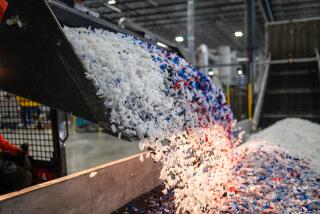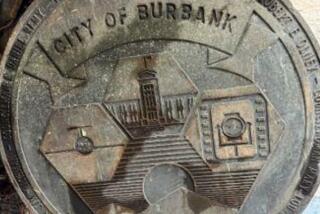City Rooting Out Recycling Scavengers
- Share via
VENTURA — Senior Waste Management Specialist Bill Lykins is off on a scavenger hunt.
The former police officer wakes at dawn and heads to the Pierpont Beach neighborhood. Eyes peeled, he cruises the streets in his brown sedan, looking for suspicious activity. Finally, he spots what he is looking for: a bearded man removing newspaper from a household recycle bin, and stashing it in the camper shell of his red pickup.
“I call it ‘looking for scavengers,’ ” Lykins says of his early morning stakeouts. “What he was doing is illegal.”
One man’s trash is another man’s treasure--and the old adage rings even truer in the age of recycling. The newspaper snatcher is one of a growing number of locals who scour neighborhoods, rummaging through curbside bins in search of newspaper, cardboard, aluminum and plastic--so they can trade it in for cash.
Some scavengers are homeless, others semiprofessional, moving quickly with pickups through their target neighborhoods shortly before collection.
In a survey from October 1995--taken when recycled cardboard and newspaper reached peak rates--the city estimated it lost $10,000 a week in theft of recyclables. This year, cardboard and newsprint prices are down, so the city only loses about $1,500 per week.
But each pound of newspaper, cardboard, aluminum or plastic that doesn’t go to local trash hauler Harrison Industries means lost revenue, says Lykins, who monitors Harrison’s contract with the city.
Theft of recyclables has become such a problem that Harrison Industries warned in its newsletter, “Trash Flash,” that if thefts do not stop, trash collection rates may rise. Lykins even met with the Ventura Police Department to train officers on the appropriate city ordinances and state laws that cover the theft of recyclables.
*
“The sale of recyclables goes to trash rates to keep them down,” Lykins says. “The city’s concern, the trash hauler’s concern and our concern is when people go through neighborhoods gathering cans and bottles, that raises the rates for the citizens.”
According to Ventura’s office of inspection services, scavengers can be fined up to $100 for their first offense, $200 for their second offense and $500 for their third.
The Police Department gives out tickets for scavenging, but Sandy Butler, a Ventura public services officer, says a lot of residents don’t report it.
“I think it is a huge problem, but a lot of it goes unreported,” she said.
The rise of the number of scavengers reflects the increase in the value of recyclable material in recent years.
In California, the recycling revolution didn’t really take hold until 1989. At that time, California landfills were filling fast, and environmentalists were pushing for wiser use of increasingly scarce resources.
The state passed a law requiring cities to trim by 25% the amount of trash taken to landfills by 1995, and 50% by the year 2000. California was on the forefront of a national move to reduce the amount of garbage flowing to landfills; today, most states have adopted legislation or goals requiring a reduction of 35% to 60%.
*
“California was different, though,” said Paul Relis, a member of California’s Integrated Waste Management Board. “We adopted a law with teeth. It’s not just a goal--cities have to prepare detailed plans.”
The law transformed the trash business in California. Trash haulers, such as Harrison Industries in Ventura, began to branch into recycling to keep their rates down, meet the new legal standard and ease into the burgeoning recycling trade.
Nan Drake, spokeswoman for Harrison Industries, Gold Coast Recycling and California Wood Recycling, says the trash industry is growing increasingly competitive. In the last three years, a number of small companies have sold out to the giants--huge companies like USA Waste and GI Industries in east Ventura County.
“Recycling is the wave of the future,” Drake says. “The Harrisons believe there will be a time when more material will be recycled than landfilled.”
Gold Coast Recycling, the public-private recycling partnership created in 1989 with the city of Ventura, takes in up to 440 tons of materials every day for recycling. California’s Integrated Waste Management Board recently approved Gold Coast’s $6-million expansion plan, which includes a new 44,000-square-foot building.
“We live, smell and eat recycling,” Drake said.
*
Inside the plant, men in hard hats and surgical masks root through the trash. Others stand along a conveyor belt and fish out metals, plastics, tires and anything else they can salvage. At the end of the belt, huge compactors smash the recycled trash into giant bales, which are piled up for shipment around the globe.
Gold Coast ships 2,000 tons of recycled fibers--newspaper, paper and cardboard--around the world each month, primarily to Japan, China, Korea and Indonesia. These resource-scarce countries pay $19 to $20 for a 600-pound bale of newsprint.
Steel, aluminum and plastics generally stay in the U.S. Aluminum sells for $1,000 a bale.
Recycling prices are volatile. From newsprint to plastics, prices fluctuate wildly because they are tied to commodity markets. Currently, the market is weak for almost everything except aluminum, “the Cadillac of recyclables.”
“We’re at an interface between the old system and a growing new system,” Relis explained. “But I think recycling is irreversible because of the degree of investments that have been made.”
In the meantime, the underground economy, where scavengers barter and trade recyclables for cash, continues to thrive--at least in Ventura, says Lykins, the watchful waste-management consultant who guards cans, bottles, and newspaper from unlicensed trash harvesters.
“I go out when we have a problem,” he says. “You have to just let people know you are out there. Then it subsides in that area, and moves somewhere else.”
More to Read
Sign up for Essential California
The most important California stories and recommendations in your inbox every morning.
You may occasionally receive promotional content from the Los Angeles Times.










